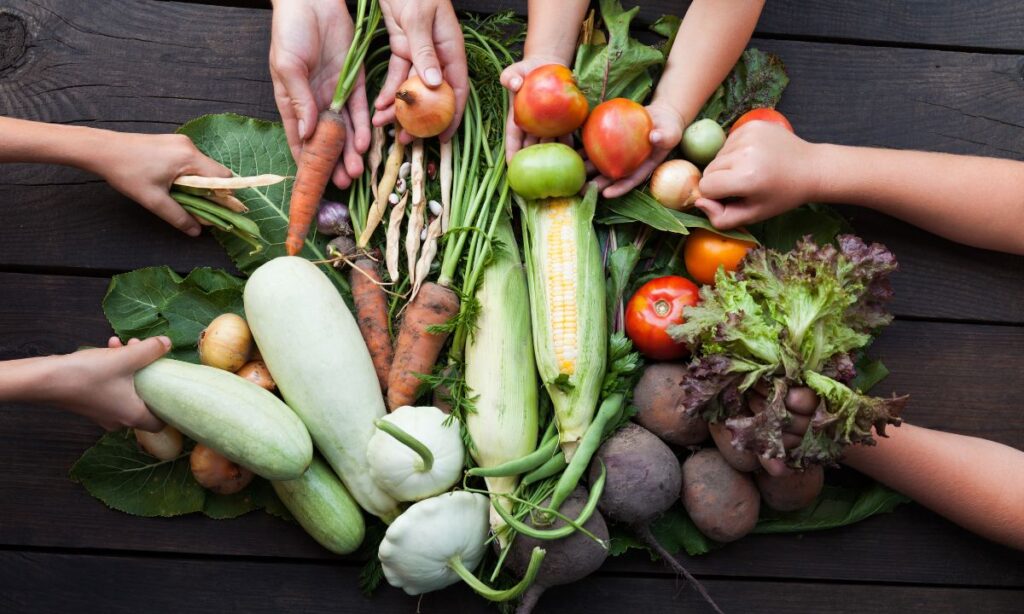In today’s fast-paced world, where concerns about the environment and personal health are on the rise, adopting a sustainable lifestyle has become a top priority for many. One significant area where we can make a positive impact is our dietary choices.
Contrary to the misconception that sustainable eating is expensive, we are here to show you how to eat sustainably on a budget without compromising on the quality of your meals or the health of the planet.
Understanding Sustainable Eating
Sustainable eating is a lifestyle that focuses on consuming foods that are not only nutritious for our bodies but also beneficial for the environment.
It involves making conscious decisions that minimize the negative impact of our food choices on the planet. This approach to eating considers factors such as sourcing, production, transportation, and waste generation.
How to Eat Sustainably on a Budget - 8 Ways
Embrace Plant-Based Foods
Plant-based foods are not only rich in essential nutrients but also have a lower environmental footprint compared to animal-based products. Incorporating more fruits, vegetables, legumes, and whole grains into your diet can have a positive impact on your health and the planet. These foods are often more affordable and versatile, allowing you to create delicious and nutritious meals.
Plant-based proteins like lentils, chickpeas, and beans are not only cost-effective but also excellent sources of protein and fiber. They can be used in a variety of dishes, from soups and stews to salads and wraps. Additionally, whole grains like quinoa, brown rice, and oats are not only budget-friendly but also provide sustained energy and essential nutrients.
Buy Local and Seasonal
Opting for locally grown produce has several benefits. Not only does it support local farmers and businesses, but it also reduces the carbon footprint associated with long transportation distances. Seasonal produce is not only fresher but also tends to be more budget-friendly due to its abundance during harvest times.
When you buy local, you’re not only getting fresh and flavorful ingredients but also supporting your community’s economy. Local farmers’ markets and community-supported agriculture (CSA) programs are great places to find affordable and locally sourced fruits, vegetables, and other products. By purchasing in-season produce, you can enjoy a variety of flavors while saving money.
Reduce Food Waste
Minimizing food waste is a crucial aspect of sustainable eating. Plan your meals, create shopping lists, and store food properly to extend its shelf life. Repurpose leftovers into new dishes to make the most of your ingredients. By reducing food waste, you can save money while contributing to a more sustainable food system.
When planning your meals, consider using versatile ingredients that can be used in multiple dishes. For example, roast a batch of mixed vegetables and use them in salads, wraps, or grain bowls throughout the week. Get creative with leftovers – turn roasted vegetables into a hearty soup or blend them into a flavorful sauce.
Meal Planning and Batch Cooking
Meal planning is an effective way to save money and reduce waste. Design a weekly meal plan that incorporates plant-based ingredients and focuses on using what you already have in your kitchen. Batch cooking larger quantities of meals allows you to portion and freeze for future consumption, making it convenient and cost-effective.
When you plan your meals ahead of time, you’re less likely to make impulsive purchases or resort to takeout. Consider preparing staples like grains, beans, and roasted vegetables in larger quantities. These ingredients can serve as building blocks for a variety of dishes, from Buddha bowls to stir-fries.

Explore Farmers' Markets
Farmers’ markets are treasure troves of fresh, local, and seasonal produce. Not only can you find a wide variety of fruits and vegetables, but you can also connect with local farmers and artisans. Prices at farmers’ markets can be competitive, and the quality and taste of the produce are often superior.
Exploring farmers’ markets allows you to discover unique and heirloom varieties of produce that may not be readily available in traditional grocery stores. Engage with farmers and vendors to learn about their growing practices and gather tips on how to select and prepare different types of produce.
Opt for Whole Foods
Processed and packaged foods tend to be more expensive and have a higher environmental impact. Whole foods such as grains, beans, and vegetables are not only nutritious but also budget-friendly. Purchase these items in bulk to further reduce costs.
When shopping for whole foods, consider visiting bulk bins at grocery stores or co-ops. Buying in bulk not only saves money but also reduces packaging waste. Stock up on staples like whole grain pasta, dried beans, and nuts. These items have a long shelf life and can be incorporated into a variety of meals.
Grow Your Own
If you have the space, consider starting a small garden at home. Growing your own herbs, fruits, and vegetables can be a rewarding and cost-effective way to incorporate fresh ingredients into your meals. Even if you have limited space, herbs can be grown on windowsills or balconies.
Growing your own food allows you to have a direct connection with the source of your meals. Herbs like basil, mint, and parsley are easy to grow and can enhance the flavor of your dishes. Additionally, consider planting a small container garden with tomatoes, peppers, or lettuce.
Practice Mindful Eating
Mindful eating involves savoring and appreciating every bite of your meal. By eating slowly and paying attention to your body’s signals, you can avoid overeating and reduce the need for frequent grocery trips. This practice can lead to a more mindful approach to food consumption and help you make better choices for both your health and the environment.
To practice mindful eating, create a calm and inviting eating environment. Turn off distractions like TV or phones, and focus on the colors, textures, and flavors of your food. Chew slowly and take breaks between bites to check in with your hunger levels. By becoming more attuned to your body’s cues, you can prevent overeating and reduce food waste.
Conclusion
In conclusion, eating sustainably on a budget is not only achievable but also a rewarding endeavor. By adopting a plant-based focus, supporting local farmers, reducing waste, and making mindful choices, you can enjoy delicious and nutritious meals while contributing to a healthier planet.
Embrace the power of sustainable eating and make a positive impact on your well-being and the world around you.


